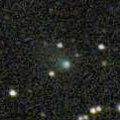
|
Now it is bright as 11.8 mag (July 4, Thomas Lehmann). It is expected to brighten up to 8 mag in autumn. In the Northern Hemisphere, it stays observable for a long time while the comet is brightening. In the Southern Hemisphere, it it not observable until mid September.
Date(TT) R.A. (2000) Decl. Delta r Elong. m1 Best Time(A, h)
July 20 4 30.57 59 39.3 1.996 1.604 52 11.4 5:34 (202,-12)
July 27 4 28.85 59 15.2 1.855 1.565 57 11.1 5:31 (200,-10)
|
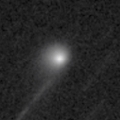
|
Now it is 13.2 mag (June 30, Thomas Lehmann). It will brighten up to 10.5 mag and it will be observable in good condition from autumn to winter. It is a bit fainter than this ephemeris recently.
Date(TT) R.A. (2000) Decl. Delta r Elong. m1 Best Time(A, h)
July 20 2 41.35 12 27.4 3.429 3.314 74 11.9 5:34 (205, 39)
July 27 2 42.80 14 4.8 3.298 3.292 80 11.8 5:31 (198, 39)
|
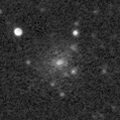
|
It brightened rapidly up to 10 mag in June. Now it is not observable. It will appear in the morning sky in October. But it will be fainter than 18 mag at that time.
Date(TT) R.A. (2000) Decl. Delta r Elong. m1 Best Time(A, h)
July 20 8 53.38 34 26.9 2.366 1.441 18 12.1 18:38 (122,-14)
July 27 9 8.85 30 36.2 2.445 1.490 15 12.6 18:42 (117,-15)
|

|
It has not been observed yet in this apparition. Now it is fainter than 18.5 mag (June 9, Martin Masek). It was expected to brighten up to 12 mag from August to September. But actually, it must be much fainter than expected. It is observable in good condition in the Northern Hemisphere. It will be low around the high light in the Southern Hemisphere.
Date(TT) R.A. (2000) Decl. Delta r Elong. m1 Best Time(A, h)
July 20 2 40.79 16 35.7 1.247 1.372 73 13.4 5:34 (203, 35)
July 27 3 1.26 20 27.4 1.215 1.363 74 13.0 5:31 (200, 32)
|
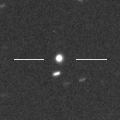
|
It is expected to brighten up to 7 mag in 2020. Appearing in the morning sky.
Date(TT) R.A. (2000) Decl. Delta r Elong. m1 Best Time(A, h)
July 20 4 43.59 17 44.1 4.497 3.849 45 13.2 5:34 (231, 19)
July 27 4 49.90 18 28.7 4.352 3.783 50 13.0 5:31 (227, 21)
|

|
Now it is not observable. It will appear in the morning sky again at 13-14 mag in August.
Date(TT) R.A. (2000) Decl. Delta r Elong. m1 Best Time(A, h)
July 20 6 22.78 19 42.6 3.108 2.196 21 13.3 5:34 (245, 0)
July 27 6 38.15 19 22.0 3.101 2.219 24 13.4 5:31 (244, 2)
|
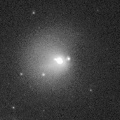
|
Now it is bright as 12.8 mag (July 4, Steffen Fritsche).
Date(TT) R.A. (2000) Decl. Delta r Elong. m1 Best Time(A, h)
July 20 1 0.07 15 17.5 5.558 5.770 96 13.4 5:11 (180, 40)
July 27 1 0.88 15 36.0 5.452 5.771 103 13.4 4:45 (180, 39)
|

|
Now it is 14.4 mag (June 30, Kevin Hills). It will brighten rapidly up to 11.5 mag in autumn. In the Northern Hemisphere, it will be observable in excellent condition. In the Southern Hemisphere, it will be extremely low from autumn to winter.
Date(TT) R.A. (2000) Decl. Delta r Elong. m1 Best Time(A, h)
July 20 0 55.73 -2 29.5 0.915 1.531 104 13.9 5:07 (180, 57)
July 27 1 10.47 0 46.5 0.853 1.503 106 13.5 4:54 (180, 54)
|
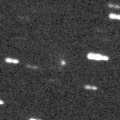
|
Now it is 14.2 mag (July 20, Chris Wyatt). It stays 13 mag for a long time in 2019. In the Southern Hemisphere, it is observable in excellent condition. In the Northern Hemisphere, it is not observasble until summer in 2020.
Date(TT) R.A. (2000) Decl. Delta r Elong. m1 Best Time(A, h)
July 20 8 3.74 -56 1.9 3.082 3.018 76 13.8 18:38 ( 38, 25)
July 27 8 11.39 -57 25.7 3.084 3.020 76 13.8 5:31 (323, 26)
|

|
It brightened up to 7.7 mag in June in 2018 (June 19, Juan Jose Gonzalez). Now it is fading. But it is still bright as 13.4 mag (May 30, Chris Wyatt). In the Southern Hemisphere, it stays observable for a long time until the comet will fade out. In the Northern Hemisphere, it is not observable for a long time until autumn when the comet fades out down to 16 mag.
Date(TT) R.A. (2000) Decl. Delta r Elong. m1 Best Time(A, h)
July 20 6 32.71 -28 40.1 4.814 4.285 53 13.9 5:34 (288, 26)
July 27 6 38.13 -28 33.9 4.857 4.342 54 14.0 5:31 (286, 29)
|
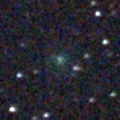
|
It brightened rapidly up to 11.2 mag from May to June (May 28, Chris Wyatt). Now it is fading. But it is still bright as 13.0 mag (July 20, Chris Wyatt). In the Southern Hemisphere, it stays observable in the evening sky for a long time after this while the comet will be fading. It is not observable at all in the Northern Hemisphere.
Date(TT) R.A. (2000) Decl. Delta r Elong. m1 Best Time(A, h)
July 20 9 38.74 -40 5.6 1.811 1.669 65 14.0 18:38 ( 62, 34)
July 27 10 15.12 -39 47.9 1.894 1.725 64 14.5 18:42 ( 62, 35)
|
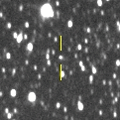
|
Now it is 14.5 mag (July 3, Thomas Lehmann). It will be observable at 13.5 mag in good condition in autumn.
Date(TT) R.A. (2000) Decl. Delta r Elong. m1 Best Time(A, h)
July 20 17 14.73 -4 16.5 1.250 2.115 137 14.3 21:23 (180, 59)
July 27 17 13.46 -4 55.9 1.262 2.080 131 14.2 20:54 (180, 60)
|
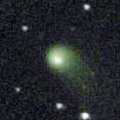
|
Now it is 13.1 mag (June 28, Thomas Lehmann). It stays 13-14 mag until summer. It is observable in excellent condition in the Southern Hemisphere. It will never be observable after this in the Northern Hemisphere.
Date(TT) R.A. (2000) Decl. Delta r Elong. m1 Best Time(A, h)
July 20 13 43.73 -42 30.5 3.336 3.682 101 14.3 18:38 ( 46, 78)
July 27 13 39.27 -42 26.0 3.479 3.712 95 14.4 18:42 ( 58, 73)
|

|
Now it is 14.4 mag (June 10, Martin Masek). In the Southern Hemisphere, it is observable for a long time. It stays low in the Northern Hemisphere.
Date(TT) R.A. (2000) Decl. Delta r Elong. m1 Best Time(A, h)
July 20 0 26.10 -45 33.5 3.577 4.180 120 14.7 4:37 ( 0, 80)
July 27 0 22.40 -45 46.1 3.540 4.201 124 14.7 4:06 ( 0, 79)
|

|
It brightens up to 15 mag from July to September. In the Southern Hemisphere, it stays observable in the low sky until it becomes fainter than 18 mag in autumn. It is not observable at all in the Northern Hemisphere.
Date(TT) R.A. (2000) Decl. Delta r Elong. m1 Best Time(A, h)
July 20 7 14.67 -8 52.1 2.197 1.429 31 15.0 5:34 (276, 7)
July 27 7 29.01 -13 0.6 2.134 1.426 35 15.0 5:31 (278, 11)
|
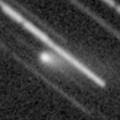
|
Now it is 15.5 mag (July 4, Thomas Lehmann). It stays at 15 mag for a while. It is observable in excellent condition in the Northern Hemisphere. It locates extremely low in the Southern Hemisphere.
Date(TT) R.A. (2000) Decl. Delta r Elong. m1 Best Time(A, h)
July 20 0 44.85 44 58.3 1.576 1.831 87 15.4 4:56 (180, 10)
July 27 0 54.25 45 50.0 1.570 1.879 90 15.6 4:38 (180, 9)
|

|
It approached to Earth down to 0.3 a.u. in mid February, and brightened up to 5.5 mag (Feb. 13, Juan Jose Gonzalez). Now it is fading. Appearing in the morning sky.
Date(TT) R.A. (2000) Decl. Delta r Elong. m1 Best Time(A, h)
July 20 4 45.47 38 7.3 3.223 2.593 44 15.7 5:34 (218, 3)
July 27 4 44.37 38 43.2 3.193 2.668 50 15.9 5:31 (213, 6)
|
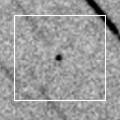
|
It passed the perihelion on July 2. Then it must have brightened up to 13 mag, but it was not observable around that time. In the Northern Hemisphere, it will appear in the morning sky at 16 mag in late July. In the Southern Hemisphere, it will be too low to observe.
Date(TT) R.A. (2000) Decl. Delta r Elong. m1 Best Time(A, h)
July 20 5 37.81 37 28.4 0.885 0.570 34 15.8 5:34 (226, -4)
July 27 5 24.09 40 6.8 0.937 0.726 43 16.1 5:31 (218, 0)
|
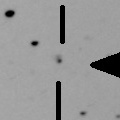
|
Asteroid, but it brightened rapidly. Now it is 16.3 mag (May 24, ATLAS-MLO, Mauna Loa). It is observable in excellent condition in the Southern Hemisphere. In the Northern Hemisphere, it locates extremely low for a while.
Date(TT) R.A. (2000) Decl. Delta r Elong. m1 Best Time(A, h)
July 20 21 31.16 -42 19.7 5.523 6.428 150 16.0 1:44 ( 0, 83)
July 27 21 21.43 -42 42.9 5.499 6.425 153 15.9 1:06 ( 0, 82)
|
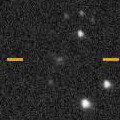
|
Now it is 16.6 mag (May 10, Mount John Observatory, Lake Tekapo). It stays 16 mag for a long time from 2019 to 2020. It is observable in excellent condition in the Southern Hemisphere. It is hardly observable in the Northern Hemisphere.
Date(TT) R.A. (2000) Decl. Delta r Elong. m1 Best Time(A, h)
July 20 10 54.11 -53 14.9 3.638 3.665 83 15.9 18:38 ( 47, 49)
July 27 10 56.23 -53 22.3 3.682 3.644 79 15.9 18:42 ( 47, 44)
|

|
Now it is 16.0 mag (June 27, Steward Observatory, Mt. Lemmon Station). It stays observable in good condition while the comet will be fading slowly after this.
Date(TT) R.A. (2000) Decl. Delta r Elong. m1 Best Time(A, h)
July 20 2 10.24 10 47.4 1.928 2.062 82 16.1 5:34 (196, 43)
July 27 2 23.50 10 51.4 1.879 2.077 86 16.0 5:31 (192, 43)
|
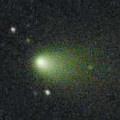
|
It brightened up to 12-13 mag from winter to spring. Now it is fading. It has already faded down to 15.1 mag (June 5, Thomas Lehmann). It will be getting lower after this. It will be unobservable in August in the Northern Hemisphere, or in September in the Southern Hemisphere.
Date(TT) R.A. (2000) Decl. Delta r Elong. m1 Best Time(A, h)
July 20 12 24.21 2 40.7 2.671 2.473 67 16.1 18:38 (136, 43)
July 27 12 33.81 1 1.3 2.772 2.499 64 16.3 18:42 (129, 41)
|
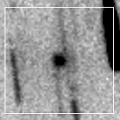
|
It was bright as 16.3 mag in May (May 23, Ken-ichi Kadota). However, it is getting diffused very much in July. The nucleus may be disintegrated. It is observable in excellent condition in the Northern Hemisphere. It is not observable in the Southern Hemisphere.
Date(TT) R.A. (2000) Decl. Delta r Elong. m1 Best Time(A, h)
July 20 14 1.50 70 35.3 1.765 1.726 70 16.1 18:38 (177,-15)
July 27 13 52.64 62 47.7 1.801 1.728 69 16.2 18:42 (172, -8)
|

|
It has not been observed yet in this apparition. It will be observable at 16 mag in good condition from summer to autumn. It locates somewhat low in the Southern Hemisphere.
Date(TT) R.A. (2000) Decl. Delta r Elong. m1 Best Time(A, h)
July 20 2 23.71 20 39.1 2.009 2.028 76 16.2 5:34 (197, 32)
July 27 2 36.03 21 53.0 1.949 2.036 80 16.1 5:31 (193, 32)
|

|
Now it is 14.2 mag (May 7, Thomas Lehmann). It will be fading after this. In the Southern Hemisphere, it stays observable for a long time until it fades out. In the Northern Hemisphere, it will not be observable after this.
Date(TT) R.A. (2000) Decl. Delta r Elong. m1 Best Time(A, h)
July 20 6 26.21 -26 0.7 5.074 4.513 51 16.2 5:34 (285, 26)
July 27 6 29.95 -27 8.8 5.086 4.564 53 16.3 5:31 (284, 30)
|

|
Now it is 16.6 mag (July 1, D. T. Durig). It stays 15-16 mag for a long time until 2021.
Date(TT) R.A. (2000) Decl. Delta r Elong. m1 Best Time(A, h)
July 20 21 41.54 -35 6.7 4.290 5.214 152 16.3 1:54 ( 0, 90)
July 27 21 32.20 -35 1.2 4.229 5.185 158 16.3 1:17 (180, 90)
|
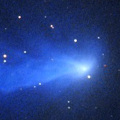
|
Now it is 16.1 mag (June 5, Toshihiko Ikemura, Hirohisa Sato). It will be fading slowly after this. It is observable in good condition in the Northern Hemisphere. In the Southern Hemisphere, it stays extremely low for a while.
Date(TT) R.A. (2000) Decl. Delta r Elong. m1 Best Time(A, h)
July 20 14 40.74 34 51.3 4.966 5.018 87 16.4 18:50 (180, 20)
July 27 14 41.66 33 21.8 5.089 5.070 83 16.5 18:42 (176, 22)
|

|
Now it is 16.1 mag (June 5, Toshihiko Ikemura, Hirohisa Sato). It will brighten up to 14 mag in winter. It stays observable for a long time in the Southern Hemisphere. It is observable only until early August in the Northern Hemisphere.
Date(TT) R.A. (2000) Decl. Delta r Elong. m1 Best Time(A, h)
July 20 15 23.90 -34 24.7 2.509 3.136 119 16.5 19:32 (180, 90)
July 27 15 14.92 -35 5.8 2.560 3.079 111 16.4 18:56 ( 0, 90)
|
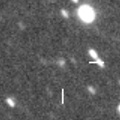
|
Now it is 17.2 mag (May 26, iTelescope Observatory, Siding Spring). It will be fading slowly after this. It is observable in excellent condition in the Southern Hemisphere. It locates low in the Northern Hemisphere.
Date(TT) R.A. (2000) Decl. Delta r Elong. m1 Best Time(A, h)
July 20 15 9.30 -40 30.1 3.081 3.658 117 16.6 19:18 ( 0, 84)
July 27 14 57.89 -40 0.2 3.194 3.651 108 16.6 18:42 ( 6, 85)
|
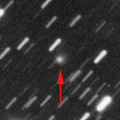
|
Now it is 16.7 mag (June 27, Thomas Lehmann). It is expected to be observable at 5-6 mag for a long time from 2022 to 2023. In the Northern Hemisphere, it is not observable at the highlight from 2022 summer to 2023 summer. In the Southern Hemisphere, it stays unobservable for a while. But it will be observable in good condition at the highlight.
Date(TT) R.A. (2000) Decl. Delta r Elong. m1 Best Time(A, h)
July 20 17 21.23 57 28.8 11.100 11.241 95 16.7 21:29 (180, -2)
July 27 17 17.74 57 0.8 11.071 11.194 94 16.7 20:58 (180, -2)
|

|
It has not been observed yet in this apparition. It will brighten up to 15.5 mag and it will be observable in good condition in autumn.
Date(TT) R.A. (2000) Decl. Delta r Elong. m1 Best Time(A, h)
July 20 23 59.18 -4 57.9 2.147 2.784 118 17.0 4:10 (180, 60)
July 27 0 2.33 -4 58.6 2.045 2.754 124 16.8 3:46 (180, 60)
|
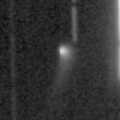
|
Now it is 16.7 mag (May 2, Kunihiro Shima). It will be fading after this. In the Northern Hemisphere, it stays observable in good condition for a long time. In the Southern Hemisphere, it stays extremely low for a long time.
Date(TT) R.A. (2000) Decl. Delta r Elong. m1 Best Time(A, h)
July 20 4 24.16 48 44.8 4.288 3.720 50 16.9 5:34 (208, -3)
July 27 4 23.80 48 54.2 4.227 3.751 55 16.9 5:31 (205, -1)
|

|
First return of a new periodic comet which brightened up to 16.5 mag in 2009. It has not been recovered yet in this apparition. It will brighten up to 16 mag in autumn. It is observable in good condition in the Northern Hemisphere. It locates low in the Southern Hemisphere.
Date(TT) R.A. (2000) Decl. Delta r Elong. m1 Best Time(A, h)
July 20 3 30.69 26 3.8 1.640 1.438 60 17.4 5:34 (211, 22)
July 27 3 58.93 27 10.5 1.584 1.399 60 17.2 5:31 (211, 20)
|

|
Now it is 17.7 mag (June 24, D. T. Durig). It will be observable at 17 mag in good condition from August to September.
Date(TT) R.A. (2000) Decl. Delta r Elong. m1 Best Time(A, h)
July 20 1 34.11 38 27.5 2.214 2.289 81 17.3 5:34 (182, 16)
July 27 1 31.18 36 52.5 2.099 2.304 88 17.2 5:15 (180, 18)
|
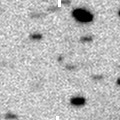
|
Now it is 16.9 mag (May 29, Toshihiko Ikemura, Hirohisa Sato). It brightens up to 17 mag in July. It is observable in good condition in the Southern Hemisphere. It locates low in the Northern Hemisphere.
Date(TT) R.A. (2000) Decl. Delta r Elong. m1 Best Time(A, h)
July 20 12 36.69 -15 17.8 0.686 1.101 77 17.3 18:38 (121, 59)
July 27 13 7.38 -22 36.3 0.716 1.149 81 17.4 18:42 (109, 63)
|

|
Now it is 18.0 mag (June 29, Michael Jager). It will brighten up to 17 mag from June to July, and will be observable in good condition.
Date(TT) R.A. (2000) Decl. Delta r Elong. m1 Best Time(A, h)
July 20 16 10.04 -8 13.5 1.650 2.376 124 17.3 20:18 (180, 63)
July 27 15 53.84 -5 39.2 1.780 2.373 113 17.5 19:34 (180, 61)
|

|
Now it is 16.4 mag (May 26, Toshihiko Ikemura, Hirohisa Sato). It is observable at 17 mag in good condition in 2019. It locates somewhat low in the Northern Hemisphere.
Date(TT) R.A. (2000) Decl. Delta r Elong. m1 Best Time(A, h)
July 20 15 11.07 -15 55.2 3.445 3.954 112 17.4 19:20 (180, 71)
July 27 15 12.32 -16 10.3 3.551 3.963 106 17.5 18:54 (180, 71)
|

|
It has not been observed yet in this apparition. It was expected to be observable at 17.5 mag from June to August. But actually, it was fainter than 21.5 mag in March (Mar. 10, Erwin Schwab).
Date(TT) R.A. (2000) Decl. Delta r Elong. m1 Best Time(A, h)
July 20 18 35.71 -15 9.3 1.116 2.100 160 17.5 22:44 (180, 70)
July 27 18 32.77 -16 27.5 1.136 2.095 153 17.5 22:13 (180, 72)
|
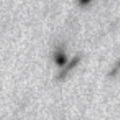
|
Now it is 17.3 mag (May 26, iTelescope Observatory, Siding Spring). In the Southern Hemisphere, it is observable at 17.5 mag in good condition from spring to summer. In the Northern Hemisphere, it is not observable at all.
Date(TT) R.A. (2000) Decl. Delta r Elong. m1 Best Time(A, h)
July 20 16 13.81 -53 11.7 3.707 4.395 127 17.8 20:23 ( 0, 72)
July 27 16 13.10 -52 21.0 3.773 4.396 121 17.8 19:55 ( 0, 73)
|
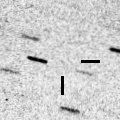
|
Peculiar asteroid moving along a cometary orbit. Now it is 19.2 mag (July 9, Katsumi Yoshimoto). It will approach to Earth down to 0.37 a.u. in mid August. Then it will brighten up to 15 mag and will be observable in good condition.
Date(TT) R.A. (2000) Decl. Delta r Elong. m1 Best Time(A, h)
July 20 2 1.03 -0 34.4 1.165 1.530 88 18.4 5:34 (197, 54)
July 27 1 47.00 -2 56.7 0.928 1.484 99 17.8 5:31 (180, 58)
|

|
In the Southern Hemisphere, it is observable at 18 mag in good condition from July to August. It locates low in the Northern Hemisphere.
Date(TT) R.A. (2000) Decl. Delta r Elong. m1 Best Time(A, h)
July 20 20 25.17 -32 42.8 2.637 3.633 166 17.9 0:38 (180, 88)
July 27 20 20.23 -33 5.7 2.635 3.630 166 17.9 0:05 (180, 88)
|

|
It has not been observed yet in this apparition. It will brighten up to 16 mag in autumn. It is observable in good condition in the Southern Hemisphere. It locates somewhat low in the Northern Hemisphere.
Date(TT) R.A. (2000) Decl. Delta r Elong. m1 Best Time(A, h)
July 20 18 40.96 -43 57.5 1.212 2.164 152 18.1 22:49 ( 0, 81)
July 27 18 34.04 -42 58.5 1.205 2.131 147 17.9 22:15 ( 0, 82)
|
|
![]()
 C/2017 T2 ( PanSTARRS )
C/2017 T2 ( PanSTARRS ) 78P/Gehrels 2
78P/Gehrels 2 29P/Schwassmann-Wachmann 1
29P/Schwassmann-Wachmann 1 260P/McNaught
260P/McNaught C/2018 A6 ( Gibbs )
C/2018 A6 ( Gibbs ) C/2016 M1 ( PanSTARRS )
C/2016 M1 ( PanSTARRS ) C/2018 W1 ( Catalina )
C/2018 W1 ( Catalina ) 68P/Klemola
68P/Klemola C/2017 M4 ( ATLAS )
C/2017 M4 ( ATLAS ) C/2017 B3 ( LINEAR )
C/2017 B3 ( LINEAR ) C/2019 A9 ( PanSTARRS )
C/2019 A9 ( PanSTARRS ) C/2019 D1 ( Flewelling )
C/2019 D1 ( Flewelling ) C/2018 Y1 ( Iwamoto )
C/2018 Y1 ( Iwamoto ) (3200) Phaethon
(3200) Phaethon A/2017 U7
A/2017 U7 C/2018 F4 ( PanSTARRS )
C/2018 F4 ( PanSTARRS ) C/2019 K5 ( Young )
C/2019 K5 ( Young ) 123P/West-Hartley
123P/West-Hartley C/2019 J2 ( Palomar )
C/2019 J2 ( Palomar ) 261P/Larson
261P/Larson C/2016 N6 ( PanSTARRS )
C/2016 N6 ( PanSTARRS ) C/2019 K7 ( Smith )
C/2019 K7 ( Smith ) C/2016 R2 ( PanSTARRS )
C/2016 R2 ( PanSTARRS ) C/2019 K1 ( ATLAS )
C/2019 K1 ( ATLAS ) C/2018 KJ3 ( Lemmon )
C/2018 KJ3 ( Lemmon ) C/2017 K2 ( PanSTARRS )
C/2017 K2 ( PanSTARRS ) 101P/Chernykh
101P/Chernykh C/2018 A3 ( ATLAS )
C/2018 A3 ( ATLAS ) P/2008 Y1 ( Boattini )
P/2008 Y1 ( Boattini ) C/2019 K4 ( Ye )
C/2019 K4 ( Ye ) 209P/LINEAR
209P/LINEAR C/2019 J3 ( ATLAS )
C/2019 J3 ( ATLAS ) 74P/Smirnova-Chernykh
74P/Smirnova-Chernykh P/2012 K3 ( Gibbs )
P/2012 K3 ( Gibbs ) 186P/Garradd
186P/Garradd A/2018 V3
A/2018 V3 215P/NEAT
215P/NEAT 160P/LINEAR
160P/LINEAR![]()



























